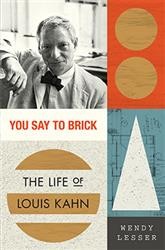By
– January 3, 2012
As the world rebuilt after World War II, Jewish architects achieved new-found prominence. In his sweeping survey of Jews and architecture, Gavriel Rosenfeld, associate professor of history at Fairfield University in Connecticut, explores the emergence of these architects, the influence of Jewish connections and themes on their work, and how they ultimately faced the memory of the Holocaust.
In the immediate aftermath of the war, modernism held sway in architecture, with its rejection of historical reference and its abstract universalism. Jewish architects — or, more accurately, assimilated Jewish architects — worked in this ahistorical style even when designing synagogues. But during this period one of the most influential and admired architects of the twentieth century, Louis Kahn, broke with modernism, and his work began to draw on the past, including the Jewish past. With the unrest of the 1960s in Europe and the United States and with a break in the silence that had surrounded the Holocaust, architecture, like the other arts, acknowledged the fragmented world and the failure of rationalism and responded with postmodernism and a return to historic reference, which for Jewish architects often meant incorporating the memory of the Holocaust and Jewish themes into their work. Holocaust museums and memorials, as well as synagogues, offered an opportunity to interpret the horror of the Shoah not only in physical architecture but also in its emotional impact.
The brutality of the Holocaust found expression in deconstructionism, exemplified architecturally by such innovators as Peter Eisenman, Daniel Libeskind, and Frank Gehry, born Frank Goldberg, all of whom experienced antisemitism and a sense of “otherness” and cited their Jewish backgrounds among their sources of inspiration. Along with Stanley Tigerman, Richard Meier, and Moshe Safdie, as well as other Jewish architects, they are internationally recognized; in the contemporary world their Jewish backgrounds and inspiration have not been obstacles to their success. Does this mean that there is a distinctive Jewish architecture, a parallel to Jewish literature or Jewish music? Rosenfeld concludes that this not the case. Rather, multiculturalism, the engagement with the Holocaust, and the postmodern movement allowed for a flowering of Jewish creativity and imagination and an embrace of Jewish themes and inspiration.
With its handsome layout, 175 photographs, and accessible if occasionally academic language, Building After Auschwitz is a rich catalogue of Jewish architecture. Brief profiles of almost every Jewish architect — Marcel Breuer, Max Abramovitz, Richard Neutra; the list is long and surprising — are a useful reference, and chapters on Israeli and postwar German Jewish architecture provide thoughtful contrasts and insights. In the end, however, Building After Auschwitz tells the reader almost as much about the Jewish experience of postwar culture and society as it does about Jewish architecture. Illustrations, index, notes.
In the immediate aftermath of the war, modernism held sway in architecture, with its rejection of historical reference and its abstract universalism. Jewish architects — or, more accurately, assimilated Jewish architects — worked in this ahistorical style even when designing synagogues. But during this period one of the most influential and admired architects of the twentieth century, Louis Kahn, broke with modernism, and his work began to draw on the past, including the Jewish past. With the unrest of the 1960s in Europe and the United States and with a break in the silence that had surrounded the Holocaust, architecture, like the other arts, acknowledged the fragmented world and the failure of rationalism and responded with postmodernism and a return to historic reference, which for Jewish architects often meant incorporating the memory of the Holocaust and Jewish themes into their work. Holocaust museums and memorials, as well as synagogues, offered an opportunity to interpret the horror of the Shoah not only in physical architecture but also in its emotional impact.
The brutality of the Holocaust found expression in deconstructionism, exemplified architecturally by such innovators as Peter Eisenman, Daniel Libeskind, and Frank Gehry, born Frank Goldberg, all of whom experienced antisemitism and a sense of “otherness” and cited their Jewish backgrounds among their sources of inspiration. Along with Stanley Tigerman, Richard Meier, and Moshe Safdie, as well as other Jewish architects, they are internationally recognized; in the contemporary world their Jewish backgrounds and inspiration have not been obstacles to their success. Does this mean that there is a distinctive Jewish architecture, a parallel to Jewish literature or Jewish music? Rosenfeld concludes that this not the case. Rather, multiculturalism, the engagement with the Holocaust, and the postmodern movement allowed for a flowering of Jewish creativity and imagination and an embrace of Jewish themes and inspiration.
With its handsome layout, 175 photographs, and accessible if occasionally academic language, Building After Auschwitz is a rich catalogue of Jewish architecture. Brief profiles of almost every Jewish architect — Marcel Breuer, Max Abramovitz, Richard Neutra; the list is long and surprising — are a useful reference, and chapters on Israeli and postwar German Jewish architecture provide thoughtful contrasts and insights. In the end, however, Building After Auschwitz tells the reader almost as much about the Jewish experience of postwar culture and society as it does about Jewish architecture. Illustrations, index, notes.
Maron L. Waxman, retired editorial director, special projects, at the American Museum of Natural History, was also an editorial director at HarperCollins and Book-of-the-Month Club.


